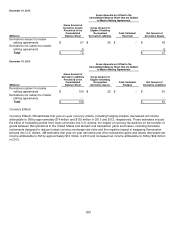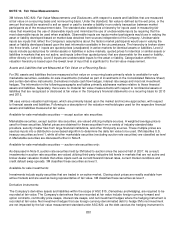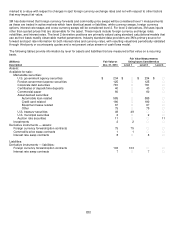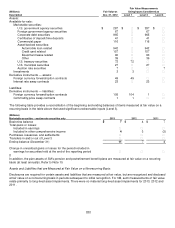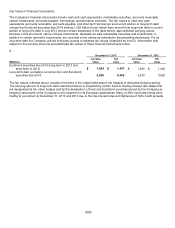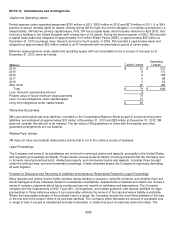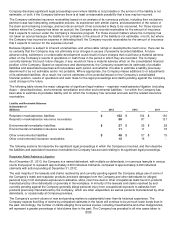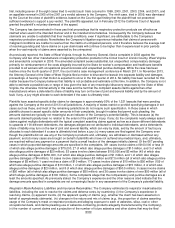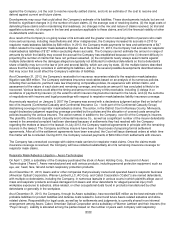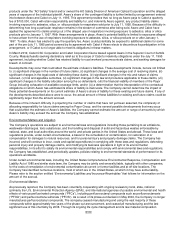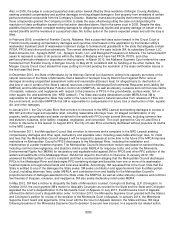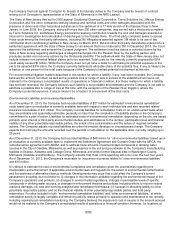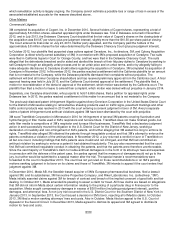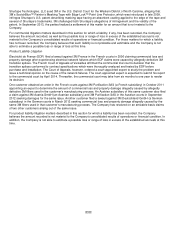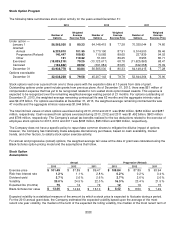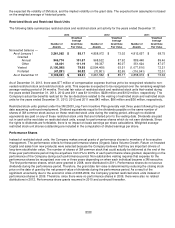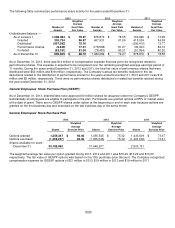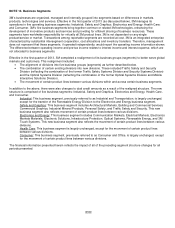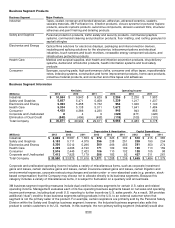3M 2013 Annual Report Download - page 112
Download and view the complete annual report
Please find page 112 of the 2013 3M annual report below. You can navigate through the pages in the report by either clicking on the pages listed below, or by using the keyword search tool below to find specific information within the annual report.106
identification processes associated with the Company’s policies covering the use of all persistent and bio-accumulative
materials, the Company has on occasion identified the presence of precursor chemicals in materials purchased from
suppliers that may ultimately degrade to PFOA, PFOS, or similar compounds. Upon such identification, the Company works
to find alternatives for such chemicals.
Regulatory activities concerning PFOA and/or PFOS continue in the United States, Europe and elsewhere, and before
certain international bodies. These activities include gathering of exposure and use information, risk assessment, and
consideration of regulatory approaches. The EPA continues to develop Drinking Water Health Advisories for PFOS and
PFOA, which are expected to be released in 2014. Those advisory levels will supersede the current provisional advisory
levels. In an effort to move toward developing standards under the Safe Drinking Water Act, the EPA published on May 2,
2012 a list of unregulated substances, including six PFCs, required to be monitored during the period 2013-2015 by public
water system suppliers to determine the extent of their occurrence.
The Company is continuing to make progress in its work, under the supervision of state regulators, to address its historic
disposal of PFC-containing waste associated with manufacturing operations at the Cottage Grove, Minnesota and Decatur,
Alabama plants.
3M completed its third and final phase of work pursuant to a Memorandum of Understanding with the EPA regarding an
environmental assessment program at the Company’s Decatur manufacturing site. That work included groundwater
sampling off-site from the 3M Decatur facility as well as at three local landfills used by the facility. The Company shared
results from this final phase of sampling work with the EPA in September 2012 and submitted an updated analysis of the
sampling work in late 2013. The submittal of the updated analysis fulfilled 3M’s obligations under the Memorandum of
Understanding.
As previously reported, the Company entered into a voluntary remedial action agreement with the Alabama Department of
Environmental Management (ADEM) to address the presence of PFCs in the soil at the Company’s manufacturing facility in
Decatur, Alabama. Pursuant to a permit issued by ADEM, for approximately twenty years, the Company incorporated its
wastewater treatment plant sludge containing PFCs in fields at its Decatur facility. After a review of the available options to
address the presence of PFCs in the soil, ADEM agreed that the preferred remediation option is to use a multilayer cap over
the former sludge incorporation areas on the manufacturing site with subsequent groundwater migration controls and
treatment. Implementation of that option will continue throughout the balance of 2014 and is expected to be completed in
2017.
The Company continues to work with the Minnesota Pollution Control Agency (MPCA) pursuant to the terms of the
previously disclosed May 2007 Settlement Agreement and Consent Order to address the presence of certain PFCs in the
soil and groundwater at former disposal sites in Washington County, Minnesota (Oakdale and Woodbury) and at the
Company’s manufacturing facility at Cottage Grove, Minnesota. Under this agreement, the Company’s principal obligations
include (i) evaluating releases of certain PFCs from these sites and proposing response actions; (ii) providing treatment or
alternative drinking water upon identifying any level exceeding a Health Based Value (“HBV”) or Health Risk Limit (“HRL”)
(i.e., the amount of a chemical in drinking water determined by the Minnesota Department of Health (MDH) to be safe for
human consumption over a lifetime) for certain PFCs for which a HBV and/or HRL exists as a result of contamination from
these sites; (iii) remediating identified sources of other PFCs at these sites that are not controlled by actions to remediate
PFOA and PFOS; and (iv) sharing information with the MPCA about certain perfluorinated compounds. During 2008, the
MPCA issued formal decisions adopting remedial options for the former disposal sites in Washington County, Minnesota
(Oakdale and Woodbury). In August 2009, the MPCA issued a formal decision adopting remedial options for the Company’s
Cottage Grove manufacturing facility. During the spring and summer of 2010, 3M began implementing the agreed upon
remedial options at the Cottage Grove and Woodbury sites. 3M commenced the remedial option at the Oakdale site in late
2010. At each location the remedial options were recommended by the Company and approved by the MPCA. Remediation
work has been completed at the Oakdale and Woodbury sites, and they are in an operational maintenance mode.
Remediation will continue at the Cottage Grove site during 2014.
The Company cannot predict what additional regulatory actions arising from the foregoing proceedings and activities, if any,
may be taken regarding such compounds or the consequences of any such actions.
Environmental Litigation
As previously reported, a former employee filed a purported class action lawsuit in 2002 in the Circuit Court of Morgan
County, Alabama, seeking unstated damages and alleging that the plaintiffs suffered fear, increased risk, subclinical injuries,
and property damage from exposure to certain perfluorochemicals at or near the Company’s Decatur, Alabama,
manufacturing facility. The Circuit Court in 2005 granted the Company’s motion to dismiss the named plaintiff’s personal
injury-related claims on the basis that such claims are barred by the exclusivity provisions of the state’s Workers
Compensation Act. The plaintiffs’ counsel filed an amended complaint in November 2006, limiting the case to property
damage claims on behalf of a purported class of residents and property owners in the vicinity of the Decatur plant. In May
2013, the Court stayed the case for an unknown period due to the filing of a bankruptcy petition by a co-defendant.


